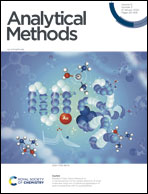Rapid identification and quantification of the antibiotic susceptibility of lactic acid bacteria using surface enhanced Raman spectroscopy†
Abstract
Overuse and misuse of antibiotics have resulted in wide antibiotic resistance in bacteria. In this study, surface-enhanced Raman spectroscopy (SERS) was used to rapidly characterize the responses of lactic acid bacteria (LAB) to antibiotics targeting the bacterial cell wall. Lactobacillus delbrueckii subsp. bulgaricus (Lb. bulgaricus) ATCC 11842 was used to represent LAB strains that are widely used in the food industry. Penicillin G, ampicillin and vancomycin were used to treat Lb. bulgaricus ATCC 11842 at different toxic levels for 30, 60 and 90 min, respectively. SERS spectra of Lb. bulgaricus after each treatment were collected to characterize the responses of Lb. bulgaricus. The collected spectra were analyzed by principal component analysis (PCA) and partial least squares regression (PLSR). Results suggested that all three antibiotics induced significant peak changes in LAB, and the spectral changes induced by each antibiotic treatment were significantly different. Moreover, the antibiotic-induced spectral changes in Lb. bulgaricus had good correlation with its proliferation ability and could be potentially used as a base for rapid quantification of the antibiotic susceptibility of bacteria. The developed method could detect the reaction of LAB to antibiotic treatments within 3 h. Therefore, the developed SERS method has the potential to be used to rapidly discriminate and quantify the antibiotic susceptibility of LAB. Moreover, such a rapid and direct method could contribute to microbial antibiotic susceptibility detection research.



 Please wait while we load your content...
Please wait while we load your content...
